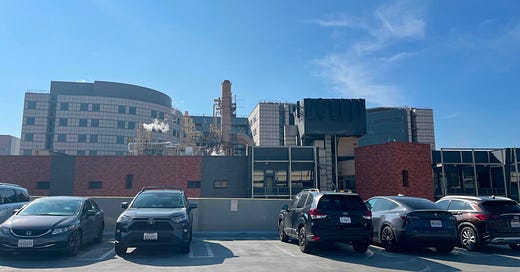On one of my first walks into Westwood, I passed by the UCLA Cogeneration Plant and assumed it was a heavy fossil fuel-consuming power plant or factory. It surprised me then that a school so vocal about sustainability would be located near a facility like that. But more recently, I learned that it is actually a cogeneration plant that is twice as efficient as a traditional plant. It relies on natural gas, in addition to renewable biogas when available, as fuel to produce electricity. The heat generated during electricity production is used to make steam, which can be used to produce more electricity, heat buildings, or produce chilled water to cool buildings. The closed-loop system of a cogeneration plant saves the heat that would otherwise be wasted.
I recently took a picture of the plant to capture how integrated it is with the campus. From a campus parking lot, you can see how the plant is located in front of the UCLA medical buildings. While this may be considered an eyesore for some, its integration with the campus buildings allows UCLA to have total control of it and make it as efficient as possible. Since the facility’s completion in 1994, it has been producing 85% of UCLA’s electrical power and saving $50 million each year on power normally purchased from the Los Angeles Department of Water and Power (LADWP). Another benefit of the plant is that it helps with water conservation efforts because water from the campus HVAC condensate reclamation system is directed to the cogeneration plant.
While natural gas is a fossil fuel that emits carbon dioxide during combustion, it emits around 50% less carbon dioxide than coal combustion. At a time when renewable energy is too expensive to implement on a large scale, natural gas usage is the first step towards cleaner energy production. According to the U.S. Energy Information Administration, from 2005 to 2019, coal usage for electricity generation has gone down from 50% to 23% while natural gas usage has increased from 19% to 38%. In the US and many other countries, natural gas is considered a “bridge fuel” for decarbonizing the energy sector.
The cogeneration plant also uses biogas as fuel from a local landfill when it is available. Biogas is a renewable source produced when organic matter like agricultural waste or sewage breaks down from anaerobic digestion. In addition to providing renewable fuel, biogas reduces discarded waste, protects soil health, and reduces nitrogen and waste runoff. Current technology, however, only makes biogas usage feasible on a small scale. In the broader scope, it would be too expensive because it is difficult to produce in densely populated areas, impurities can corrode metals, and the temperature during production must be maintained around 37 degrees Celsius.
Taking a step back from the cogeneration plant in the image, you can see how the parking lot contains traditional gas vehicles and an electric Tesla (second from the right). The presence of an electric vehicle in a parking lot with predominantly gas vehicles represents how there is currently a shift to sustainable electric vehicles that don’t directly produce emissions. The majority of the vehicles in the photo still depend on gasoline, which shows how more technological advancements are needed to lower the upfront costs of electric vehicles.
Something I like about the cogeneration plant is that the internal machinery is on display. I believe the power infrastructure that we all depend on should not just be hidden away, and seeing the machinery can bring the topic of clean energy up to passersby. The bright, blue sky contrasts the darker colors of the facility and its machinery to create a feeling that the facility is out of place with the natural environment. The plant being very noticeable in the middle of Westwood shows how these crucial systems aren’t something that is magically hidden away. They are always prominent in the surrounding community – and in many other cases, they are disproportionately located in low-income areas. As policymakers and scientists work to implement clean energy on a larger scale, it is important that they also address issues of environmental injustice. It should be a priority to bring clean energy to communities that have a higher risk of exposure to air pollution and hazardous waste.
What is to come for the future of sustainable energy at UCLA? Given that natural gas combustion still emits toxic pollutants and carbon dioxide, the facility hopes to increase biogas usage in the future. Eric Fournier, research director at the California Center for Sustainable Communities at UCLA, discussed in past interviews the challenges of using other types of renewable energy. Fournier explains how there isn’t enough space for solar panels and since UCLA has a high energy use intensity, it will be difficult to transition to reliable renewable energy that doesn’t put sensitive research equipment at risk. Hopefully, as clean energy efforts continue to gain momentum, new research and technology will make renewable energy a more reliable fuel option for UCLA.
I chose to photograph the cogeneration plant because I wanted to capture a moment of the clean energy transition in a place I have a personal connection to. The plant serves as both a reminder of our dependency on fossil fuels and an optimistic sign of progress toward more sustainable energy usage.
Resources:





wow!!!! i had no idea, this is so crazy! thanks for bringing attention to this! you go queen!!!
Hi Emma! I find it interesting that the plant provides 85% of UCLA’s electrical power, saving $50 million annually, and plays a role in water conservation by utilizing the campus's HVAC condensate system. Furthermore, I like how you touch on the broader energy landscape, noting the shift towards sustainable electric vehicles but acknowledging the challenges in making renewable energy more accessible and affordable.